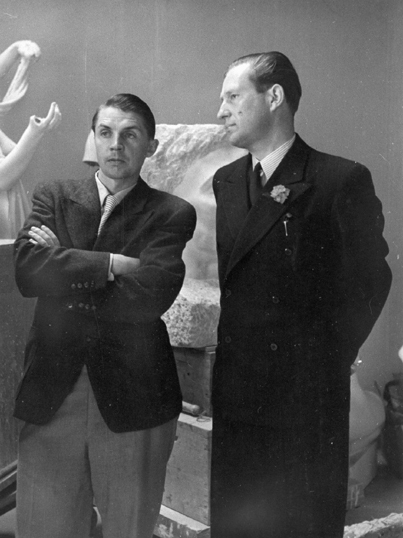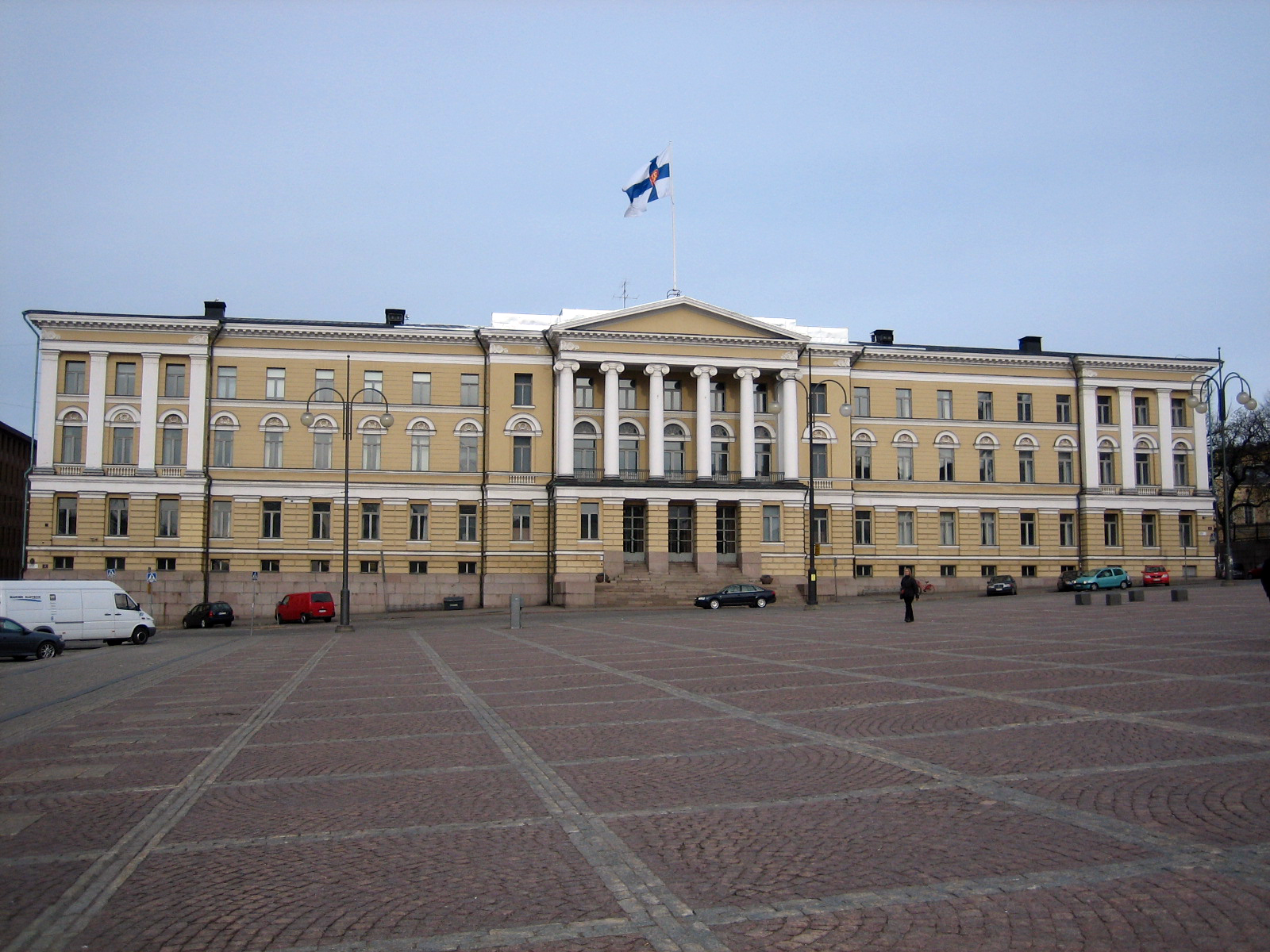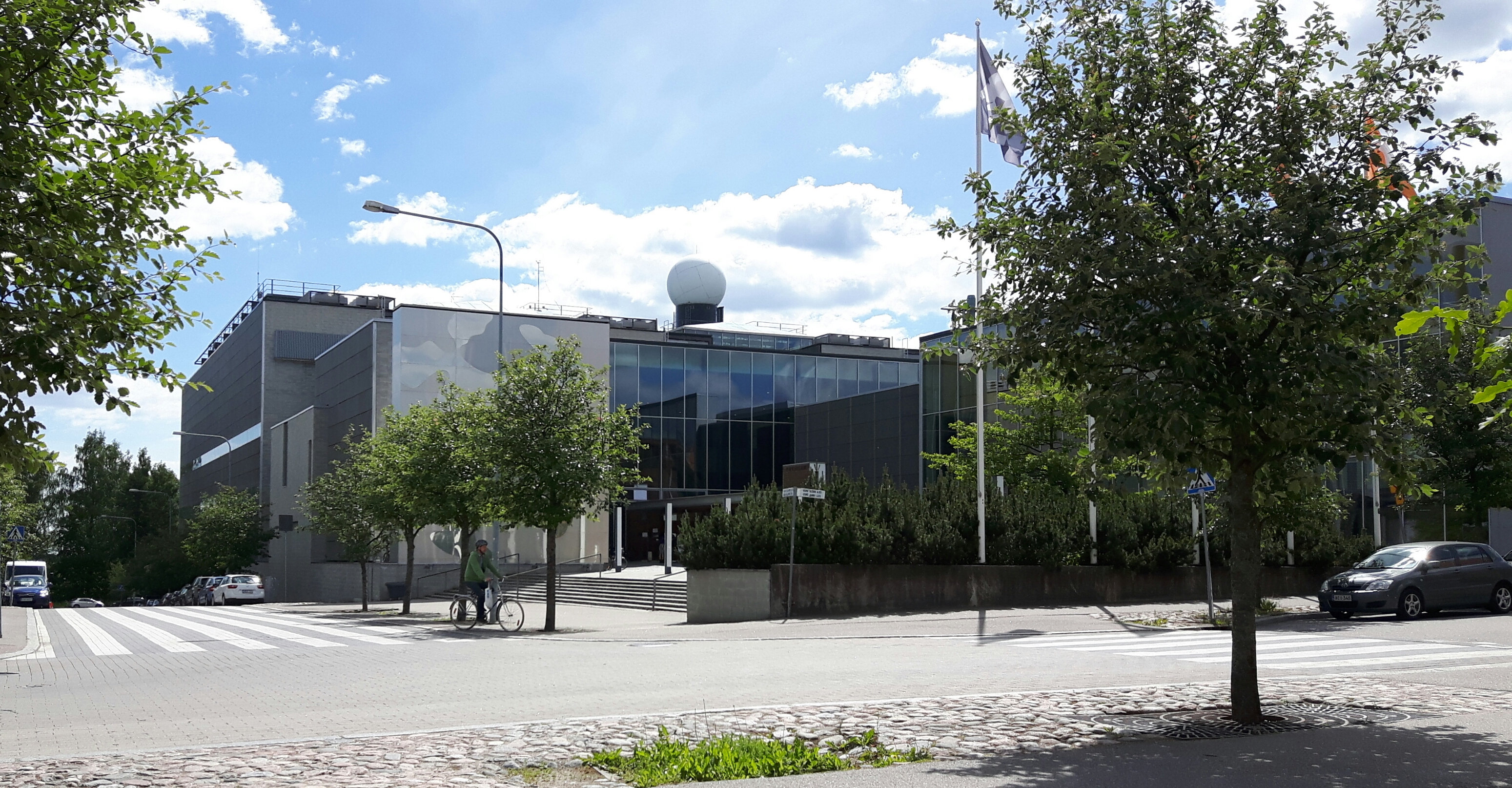|
Porthania
Porthania is a university building located in the center of Helsinki, Finland. It is part of the city centre campus of the University of Helsinki. Designed by Aarne Ervi and completed in 1957, it is one of the notable modernist buildings from the 1950s in the center of Helsinki. The building is named after Henrik Gabriel Porthan and is currently mainly used by the Faculty of Law. Features The heart of Porthania is the two-storeys high central hall which is decorated by two large murals by Arvid Broms and Olli Miettinen. Four auditoriums line the central hall, the largest of which seats 650 people and is still the largest auditorium in the whole university. Above the hall on the second floor is a student canteen. The upper five floors of Porthania house smaller auditoriums and offices. See also * Kumpula Campus * Meilahti Campus * Viikki Campus The Viikki Campus ( fi, Viikin kampus, sv, Campus Vik) is a campus area of the University of Helsinki in Finland, focusing on biol ... [...More Info...] [...Related Items...] OR: [Wikipedia] [Google] [Baidu] |
Aarne Ervi
Aarne Adrian Ervi (originally Aarne Adrian Elers) (19 May 1910 – 26 September 1977) was one of the most important architects of Finland's post-World War II reconstruction period. Ervi was born in Forssa, and graduated as an architect from the Helsinki University of Technology in 1935. After his graduation, he worked in the architect offices of Alvar Aalto and Toivo Paatela, before starting his own office in 1938. Ervi completed his most notable and well-known works during the post-war reconstruction period and later in the 1950s during the development of Finland's modern construction industry. Ervi was among the pioneers in the use of concrete elements in Finnish architecture while working on the design of the University of Helsinki's Porthania building in 1949. He also designed hydro power plants and residential areas for the company's employees for Oulujoki Oy. One of Finland's largest hydro power plants in Pyhäkoski was designed by Ervi, as was nearly all of the nearby ... [...More Info...] [...Related Items...] OR: [Wikipedia] [Google] [Baidu] |
Henrik Gabriel Porthan
Henrik Gabriel Porthan (1739 in Viitasaari – 1804 in Turku) was a professor and rector at the Royal Academy of Turku. He was a scholar sometimes known as ''The Father of Finnish History''. Biography He was born at Viitasaari in Tavastland, Finland. Parents were Sigfrid Porthan and Kristina Juslenius. His father was a vicar who became mentally ill in 1744. He was raised by his uncle Gustaf Juslenius (1702-1774) who was the vicar of Kronoby in the county of Ostrobothnia. In 1754, at the age of 15, Porthan entered the Royal Academy of Turku (now University of Helsinki). He was a student of professor Daniel Juslenius (1676–1752) who later served at Bishop of the Diocese of Borgå. Porthan was awarded his Master of Philosophy in 1760. In 1762, he became an associate professor. He was a professor 1777–1804 and served as rector 1786–1787 and 1798–1799. He became a Fennophile and brought Finnish history-writing, study of mythology and folk poetry, and other humanistic ... [...More Info...] [...Related Items...] OR: [Wikipedia] [Google] [Baidu] |
Modernism
Modernism is both a philosophy, philosophical and arts movement that arose from broad transformations in Western world, Western society during the late 19th and early 20th centuries. The movement reflected a desire for the creation of new forms of art, philosophy, and social organization which reflected the newly emerging industrial society, industrial world, including features such as urbanization, architecture, new technologies, and war. Artists attempted to depart from traditional forms of art, which they considered outdated or obsolete. The poet Ezra Pound's 1934 injunction to "Make it New" was the touchstone of the movement's approach. Modernist innovations included abstract art, the stream-of-consciousness novel, montage (filmmaking), montage cinema, atonal and twelve-tone music, divisionist painting and modern architecture. Modernism explicitly rejected the ideology of Realism (arts), realism and made use of the works of the past by the employment of reprise, incorpor ... [...More Info...] [...Related Items...] OR: [Wikipedia] [Google] [Baidu] |
Helsinki
Helsinki ( or ; ; sv, Helsingfors, ) is the Capital city, capital, primate city, primate, and List of cities and towns in Finland, most populous city of Finland. Located on the shore of the Gulf of Finland, it is the seat of the region of Uusimaa in southern Finland, and has a population of . The Helsinki urban area, city's urban area has a population of , making it by far the List of urban areas in Finland by population, most populous urban area in Finland as well as the country's most important center for politics, education, finance, culture, and research; while Tampere in the Pirkanmaa region, located to the north from Helsinki, is the second largest urban area in Finland. Helsinki is located north of Tallinn, Estonia, east of Stockholm, Sweden, and west of Saint Petersburg, Russia. It has History of Helsinki, close historical ties with these three cities. Together with the cities of Espoo, Vantaa, and Kauniainen (and surrounding commuter towns, including the eastern ... [...More Info...] [...Related Items...] OR: [Wikipedia] [Google] [Baidu] |
University Of Helsinki
The University of Helsinki ( fi, Helsingin yliopisto, sv, Helsingfors universitet, abbreviated UH) is a public research university located in Helsinki, Finland since 1829, but founded in the city of Turku (in Swedish ''Åbo'') in 1640 as the Royal Academy of Åbo, at that time part of the Swedish Empire. It is the oldest and largest university in Finland with the widest range of disciplines available. In 2020, around 31,600 students were enrolled in the degree programs of the university spread across 11 faculties and 11 research institutes. As of 1 August 2005, the university complies with the harmonized structure of the Europe-wide Bologna Process and offers bachelor, master, licenciate, and doctoral degrees. Admission to degree programmes is usually determined by entrance examinations, in the case of bachelor's degrees, and by prior degree results, in the case of master and postgraduate degrees. Entrance is particularly selective (circa 15% of the yearly applicants are admi ... [...More Info...] [...Related Items...] OR: [Wikipedia] [Google] [Baidu] |
Finland
Finland ( fi, Suomi ; sv, Finland ), officially the Republic of Finland (; ), is a Nordic country in Northern Europe. It shares land borders with Sweden to the northwest, Norway to the north, and Russia to the east, with the Gulf of Bothnia to the west and the Gulf of Finland across Estonia to the south. Finland covers an area of with a population of 5.6 million. Helsinki is the capital and largest city, forming a larger metropolitan area with the neighbouring cities of Espoo, Kauniainen, and Vantaa. The vast majority of the population are ethnic Finns. Finnish, alongside Swedish, are the official languages. Swedish is the native language of 5.2% of the population. Finland's climate varies from humid continental in the south to the boreal in the north. The land cover is primarily a boreal forest biome, with more than 180,000 recorded lakes. Finland was first inhabited around 9000 BC after the Last Glacial Period. The Stone Age introduced several differ ... [...More Info...] [...Related Items...] OR: [Wikipedia] [Google] [Baidu] |
City Centre Campus
The City Centre Campus ( fi, Keskustakampus, sv, Centrumcampus) is one of the four campus areas of the University of Helsinki. It is located at the historic centre of Helsinki. The campus houses the following faculties: *Faculty of Arts *Faculty of Behavioural Sciences *Faculty of Law *Faculty of Social Sciences *Faculty of Theology In addition, the university central administration and several independent research institutes. See also *Kumpula Campus * Meilahti Campus *University of Helsinki *Viikki Campus The Viikki Campus ( fi, Viikin kampus, sv, Campus Vik) is a campus area of the University of Helsinki in Finland, focusing on biological sciences. It comprises following units: *Faculty of Agriculture and Forestry *Faculty of Biosciences *Facult ... References Buildings and structures in Helsinki University of Helsinki Campuses {{Finland-university-stub ... [...More Info...] [...Related Items...] OR: [Wikipedia] [Google] [Baidu] |
Kumpula Campus
The Kumpula Campus ( fi, Kumpulan kampus, sv, Campus Gumtäkt) is a science campus of University of Helsinki. The campus is located some four kilometres from the centre of Helsinki, in the Kumpula district. Completed in 2005, it currently provides study and research facilities for about 6,000 students and 1,000 teachers/researchers. Departments of the Faculty of Science The University of Helsinki departments housed on the campus are: * Department of Chemistry * Department of Computer Science * Department of Geosciences and Geography * Department of Mathematics and Statistics * Department of Physics Other institutions A number of related or independent institutions are housed on the campus, e.g.: * The Finnish Institute for Verification of the Chemical Weapons Convention (VERIFIN) * The Finnish Museum of Natural History Dating Laboratory * The Helsinki Institute of Physics (HIP) * The Helsinki Institute for Information Technology (HIIT) * The Institute of Seismology * The Lu ... [...More Info...] [...Related Items...] OR: [Wikipedia] [Google] [Baidu] |
Meilahti Campus
The Meilahti Campus ( fi, Meilahden kampus, sv, Campus Mejlans) is a campus area of the University of Helsinki in Finland. It houses the Faculty of Medicine and many medical research institutions. Several hospitals are also concentrated in the area. See also * City Centre Campus * Kumpula Campus * University of Helsinki * Viikki Campus The Viikki Campus ( fi, Viikin kampus, sv, Campus Vik) is a campus area of the University of Helsinki in Finland, focusing on biological sciences. It comprises following units: *Faculty of Agriculture and Forestry *Faculty of Biosciences *Facult ... Buildings and structures in Helsinki University of Helsinki Meilahti Ruskeasuo University and college campuses in Finland {{Finland-university-stub ... [...More Info...] [...Related Items...] OR: [Wikipedia] [Google] [Baidu] |
Viikki Campus
The Viikki Campus ( fi, Viikin kampus, sv, Campus Vik) is a campus area of the University of Helsinki in Finland, focusing on biological sciences. It comprises following units: *Faculty of Agriculture and Forestry *Faculty of Biosciences *Faculty of Pharmacy *Faculty of Veterinary Medicine *Institute of Biotechnology *Viikki Science Library Besides these units of the University of Helsinki, the campus area also hosts the Helsinki Science Park and the Finnish Food Safety Authority. The campus is located in the rapidly developing area of Viikki in Helsinki, about 10 km from the city center. It is closely associated with the Helsinki Business Park. The nearby arboretum, nature conservation area of Vanhankaupunginlahti and the experimental farm form a rare haven of countryside and wildlife at the heart of the capital city area. At the center of the campus lies the Viikki Info Center, which is unique in Finland, as it hosts both the local municipal public library and a scie ... [...More Info...] [...Related Items...] OR: [Wikipedia] [Google] [Baidu] |
Buildings And Structures In Helsinki
A building, or edifice, is an enclosed structure with a roof and walls standing more or less permanently in one place, such as a house or factory (although there's also portable buildings). Buildings come in a variety of sizes, shapes, and functions, and have been adapted throughout history for a wide number of factors, from building materials available, to weather conditions, land prices, ground conditions, specific uses, prestige, and aesthetic reasons. To better understand the term ''building'' compare the list of nonbuilding structures. Buildings serve several societal needs – primarily as shelter from weather, security, living space, privacy, to store belongings, and to comfortably live and work. A building as a shelter represents a physical division of the human habitat (a place of comfort and safety) and the ''outside'' (a place that at times may be harsh and harmful). Ever since the first cave paintings, buildings have also become objects or canvasses of much artistic ... [...More Info...] [...Related Items...] OR: [Wikipedia] [Google] [Baidu] |



.jpg)


